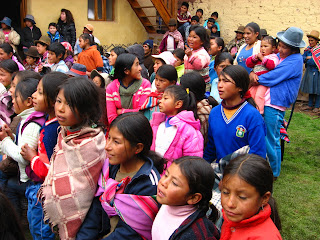We took a bus out to Puno on Wednesday morning last week. The scenery between Cusco and Puno is stunning. There is no other word for it. Right up until you get to Juliaca, maybe the ugliest city I've ever seen in my life....
This is a video I shot from the bus as we were going from Cusco to Puno.
Shot this one as well, but it's of one of the typical villages nestled in the mountains, rather than just scenery.
Puno and Lake Titicaca, as viewed from the top floor sun room at our hostel.
We only spent a day and a half in and around Puno (plenty enough time). First thing first, had to get a room at a hostel. Highly recommended came the Duque Inn, run by a fabulous retired archeologist who'd specialized on the Puno Provence. He was a wealth of information and a wonderful resource when we had question after tours of places. Also, there was hot hot hot water in the showers (unlike in Cusco), so we were very happy. It was already 5-ish by the time we were settled, so we went to the big cathedral in the main square and then found a place for dinner and walked around the main area of Puno for a bit in the evening.
Thursday was adventure day! In the morning, despite the rain, we took a boat out to the floating islands of Uros.
Lake Titicaca
Reeds in the water
coming up on the islands
You may ask "What, pray tell, is a floating island?" Well, it's a floating island made of reeds and there are little houses on top! In the winter (dry season) the reed roots become dislodged from the bottom of the lake and they cut these roots into 5mx5m blocks and tie them together to make the base of the island. Then they layer reeds on top until its 2m thick total. They add fresh reeds on top of this as needed. And of course, the houses are built on top of this, and are also made of reeds...
picture of the reed roots that are used to make up the bases of the floating islands
"floor" of the island, made of layered reeds
pet cormorants...
After the island building had been explained to us, the local women brought out there embroidery for us to see/buy (they have to make money from this somehow yea?) I bought a traditional embroidery of their local gods from one of the women, and got a picture of her holding up one of the other embroideries she'd made.

We took a reed boat from one island to another, rowed by the leader of the island and a few of the other men. This one was more touristy (unavoidable) but the boat was cool, and then we motored back to the mainland.
The reed boat

This is one of the kids of he island leader.... He didn't look to happy to be there.
Then in the afternoon, we went to Sillustani. Sillustani is a pre-Incan burial ground on the shores of Lake Umayo near Puno in Peru. The tombs, which are built above ground in tower-like structures called chullpas, are the vestiges of the Colla people, Aymara who were conquered by the Inca in the 15th century. The structures housed the remains of complete family groups, although they were probably limited to nobility. Many of the tombs have been dynamited by grave robbers, while others were left unfinished, and all of them are now in the process of being reconstructed by the INC (archeology dpt of the Ministry of Culture). I feel like it'd be easier to re-construct them if they weren't made out of magnetic volcanic rock (from the nearest volcano, on the far side of the mountain top they're on) and they'd stop being struck by lightening....
Lake Umayo and colonial church at the bottom of the site.
Look at that super precise architecture!
Me standing next to the tallest of the reconstructed burial towers (scale reference).
Lake Umayo, which holds an island that is inhabited by a single house and a heard of Vicuna...
Chullpas being reconstructed.
The Altiplano, outside of Puno on the way back from Sillustani.
After returning from Sillustani, we went to the Carlos Dryer Museum of Archeology. Carlos Dryer was an ex-pat painter/archeologist who lived in Puno for most of his life, and the museum is made up of his collection, plus artifacts from the region. They had 3 mummies, and it was the first time I'd seen gold at one of the museums (usually they don't put the gold out because people break in and try to steal it).
Next morning, bus trip back to Cusco. More beautiful scenery! Got back around 3, exhausted, but happy and recharged (I'd been feeling like I needed to get away from Cusco for a few days).


















